This is our step-by-step guide on how to dehydrate cilantro. Dehydrating cilantro is real easy to do and a great first dehydrator project that anyone can probably do.
Cilantro is a versatile herb that can add a bold and zesty flavor to many dishes. However, it can be frustrating when you buy a bunch of fresh cilantro only to watch it wilt away in the fridge before you have a chance to use it all. This is where dehydrating cilantro comes in.
By dehydrating fresh cilantro, you can preserve its flavor and extend its shelf life. Whether you want to use it for cooking, camping, or making homemade spice blends, dehydrating cilantro is a convenient and practical option.
In this step-by-step guide, we will show you everything you need to know to successfully dehydrate cilantro at home. From choosing the right equipment to preparing the cilantro, we will cover every aspect of the process.
So, grab your dehydrator, and let’s get started!
Table of Contents
- How to Dehydrate Cilantro
- Supplies Needed for Dehydrating Cilantro
- Step 1. Process the Cilantro for Dehydrating
- Step 2. Preparing the Dehydrator for Dehydrating Cilantro
- Step 3. Dehydrating the Cilantro
- Step 4. When is the Dehydrated Cilantro Done
- Step 5. Equalizing and Conditioning of the Dehydrated Cilantro
- Step 6. Storing Dehydrated Cilantro
- Spice Grinding
- Weights, Measures, and Serving Sizes
- Dehydrated Cilantro Nutrition Information
- Insider Tips
How to Dehydrate Cilantro
Dehydrating food at home is a useful skill to have for several reasons. First, it allows you to preserve fresh produce and extend its shelf life, reducing food waste and saving you money. Dehydrated food can last for many months if stored properly, making it a great option for stocking up on seasonal produce or for creating your own emergency food supply.
Dehydrated cilantro is simply fresh cilantro that has been dried out to remove moisture. The process of dehydrating cilantro involves removing the water content from the fresh herb, which can be done using a food dehydrator.
Dehydrated cilantro is a convenient alternative to fresh cilantro, as it can be stored for longer periods of time without spoiling and can be used in recipes that call for fresh cilantro.
While fresh cilantro is a good source of vitamins and minerals such as vitamin C, vitamin K, and potassium, some of these nutrients can be lost during the dehydration process. However, dehydrated cilantro can still be a source of flavor and can add flavor to our homemade dehydrated camping meal packets.
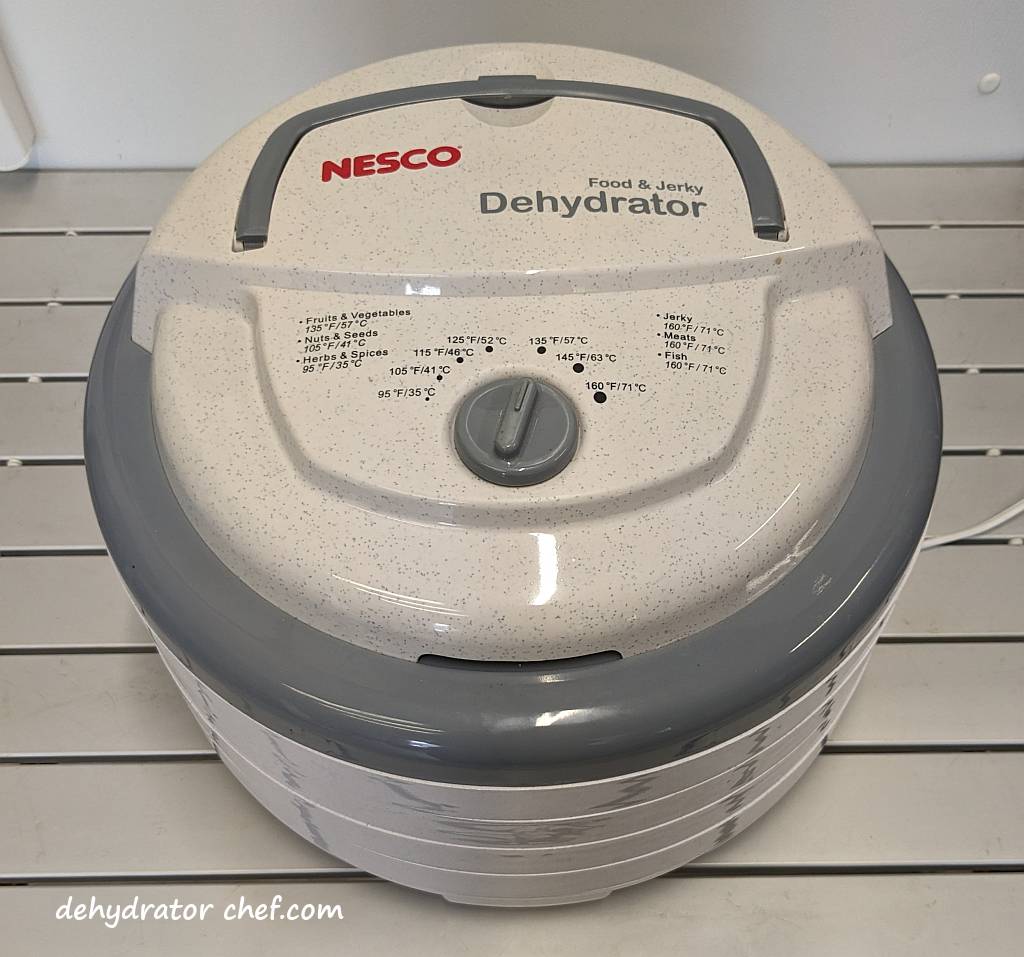
All you need to dehydrate cilantro is a good quality food dehydrator. We use the Nesco food dehydrators. You can check out our food dehydrator guide to learn why we think Nesco offers the best bang for the buck. We believe this is the best food dehydrator for our long-term food storage needs.
For planning purposes, one bunch of processed cilantro will fill 1 to 2 of the Nesco 13.5-inch round dehydrator trays.
You’ll also need the removable fruit roll sheet inserts; one is needed for each dehydrator tray.

Supplies Needed for Dehydrating Cilantro
- A bunch or two of store-bought cilantro
- Common kitchen tools such as cutting boards, chef’s knife, colander, etc.
- Food dehydrator, with removable fruit roll sheet inserts for the dehydrator trays
- Clear canning jars
- Wide-mouth canning funnel
- Spice jar funnel
- Spice grinder
- Spice jars
Step 1. Process the Cilantro for Dehydrating
We start by trimming the stem ends. Maybe about half an inch, just enough to trim off any discoloring.
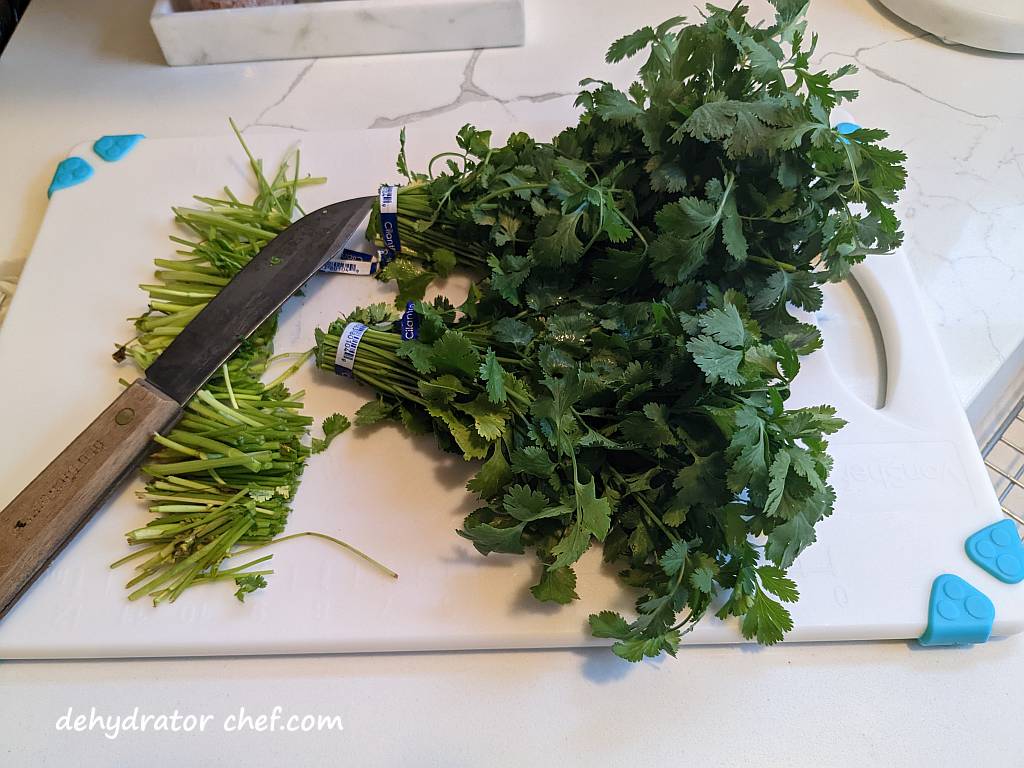
Then, pick through the bunch to remove any stems that might be past their prime or critters that may be along for the ride.
Give everything a good and thorough cold water rinse. The cilantro we buy usually has some dirt and grit residue. So we just rinse it all away with cold water. Give it all a couple of good shakes to remove excess water. Don’t worry about getting it all completely dry.
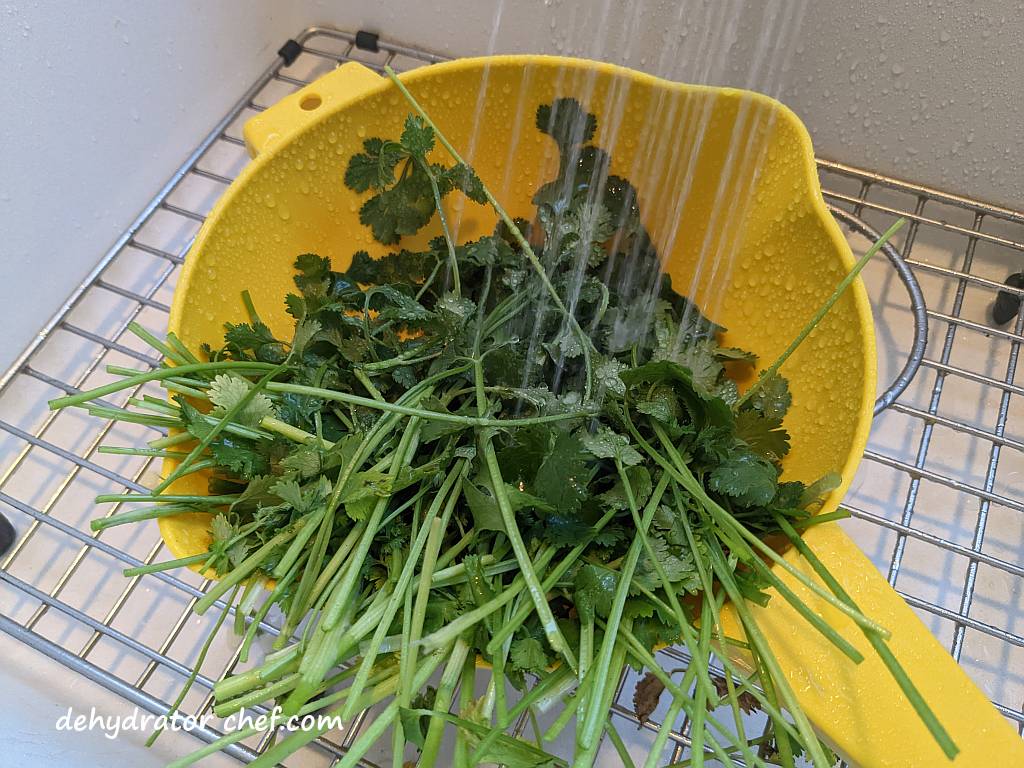
Next, give the cilantro a rough chop. Yes, including the stems. There are a lot of cilantro flavors there.
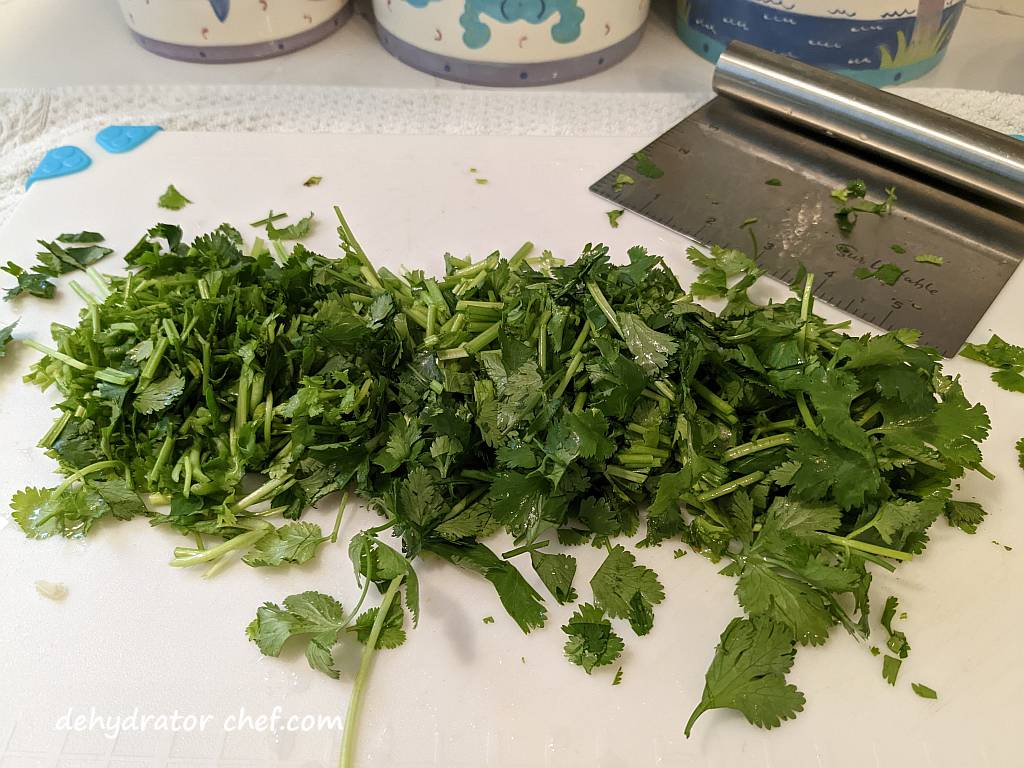
That’s it. Easy enough.
Step 2. Preparing the Dehydrator for Dehydrating Cilantro
Spread out and layer the chopped cilantro onto the fruit roll sheets. Try to get a thin layer for faster drying times.
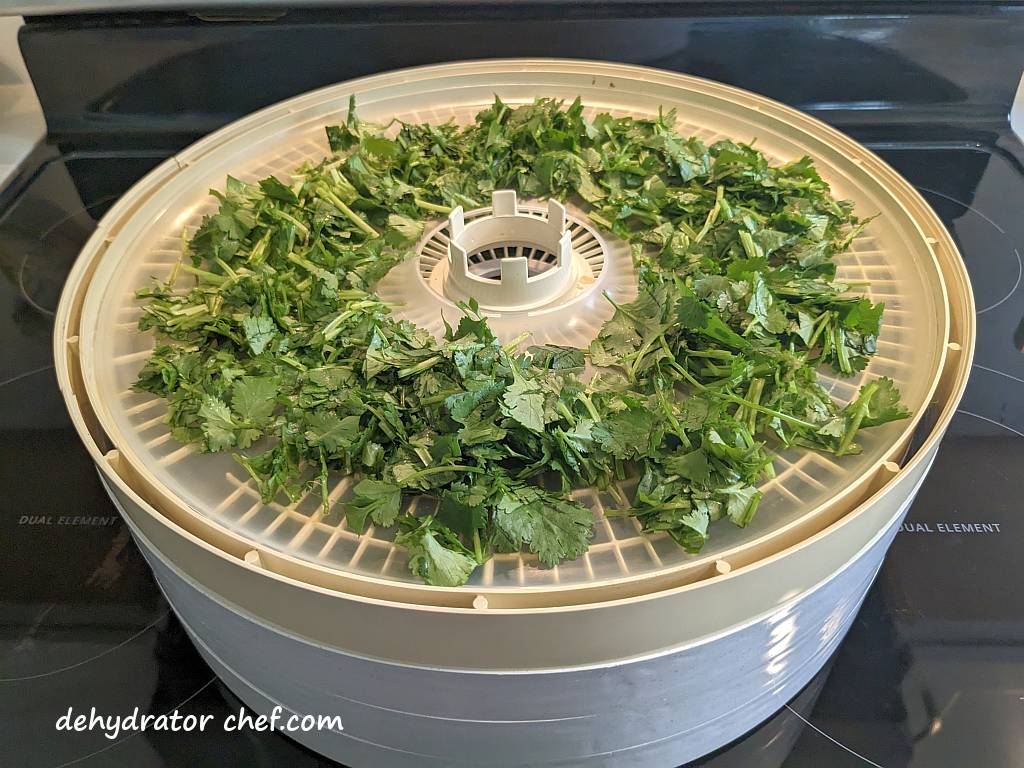
For planning purposes, for every bunch of roughly chopped cilantro, we probably average two of the Nesco 13.5-inch round dehydrator trays. Of course, some cilantro bunches are bigger; some are smaller.
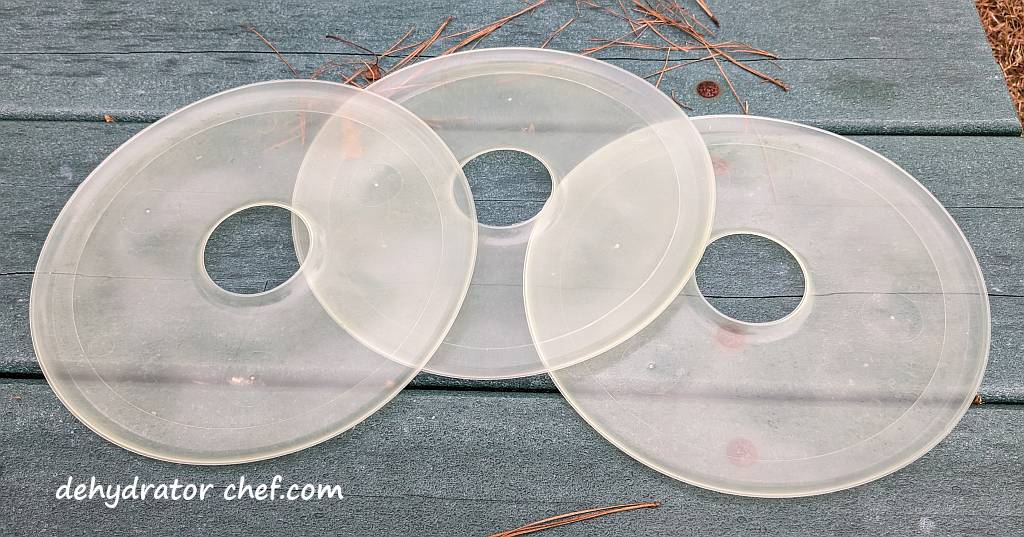
We will use these removable Nesco fruit roll sheet inserts on our food dehydrator for today’s project. They have over 3000 customer reviews with an average rating of 4.5 stars out of 5, which is evidence of a great product. Check out other Nesco food dehydrator products here.
Step 3. Dehydrating the Cilantro
For dehydrating cilantro, set the dehydrator temperature to 135 °F / 57 °C. I find that 18 to 24 hours is about the right amount of time. Letting it go overnight works best for our work schedules.
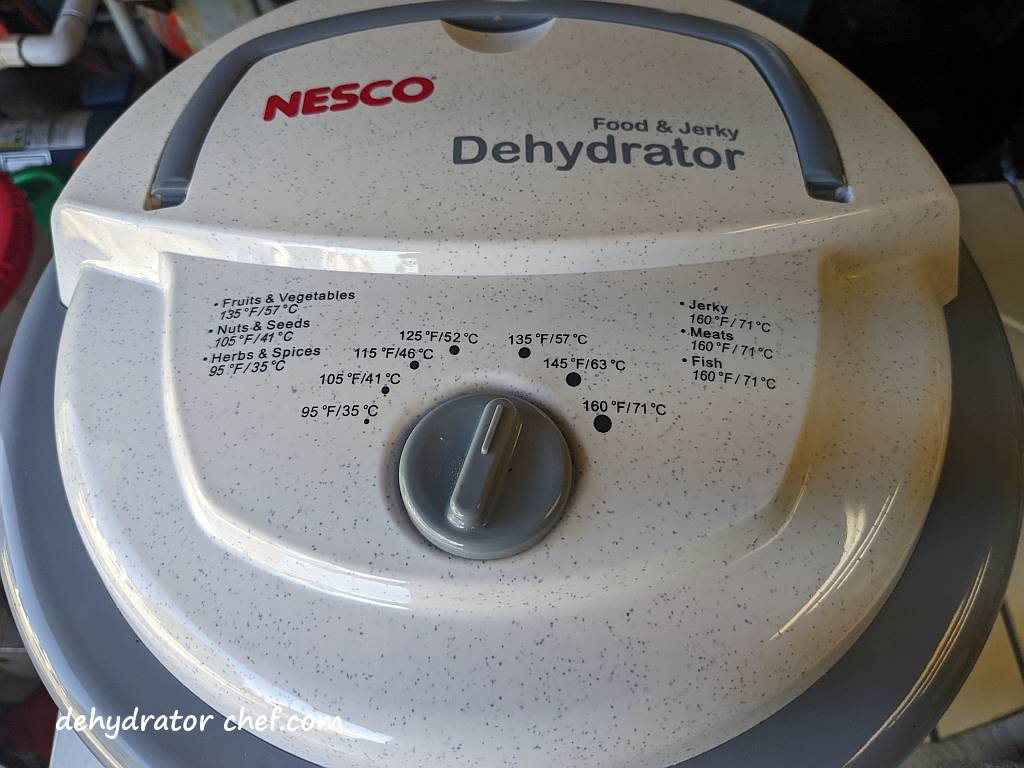
I can chop up a batch in the late morning or early afternoon, and it will likely have finished drying by the next morning.
Of course, drying times are dependent on your food dehydrator, the ambient temperature and humidity, and how crowded you fill your trays. Remember to use drying times as a guide.
Step 4. When is the Dehydrated Cilantro Done
After 18 to 24 hours, the cilantro should be fully dehydrated. If not, let it go another 2 or 4 hours and check again.
Drying times will vary depending on your dehydrator. Refer to your dehydrator owner’s manual for recommended temperatures and times for dehydrating specific foods. Remember to use drying times as a guide.
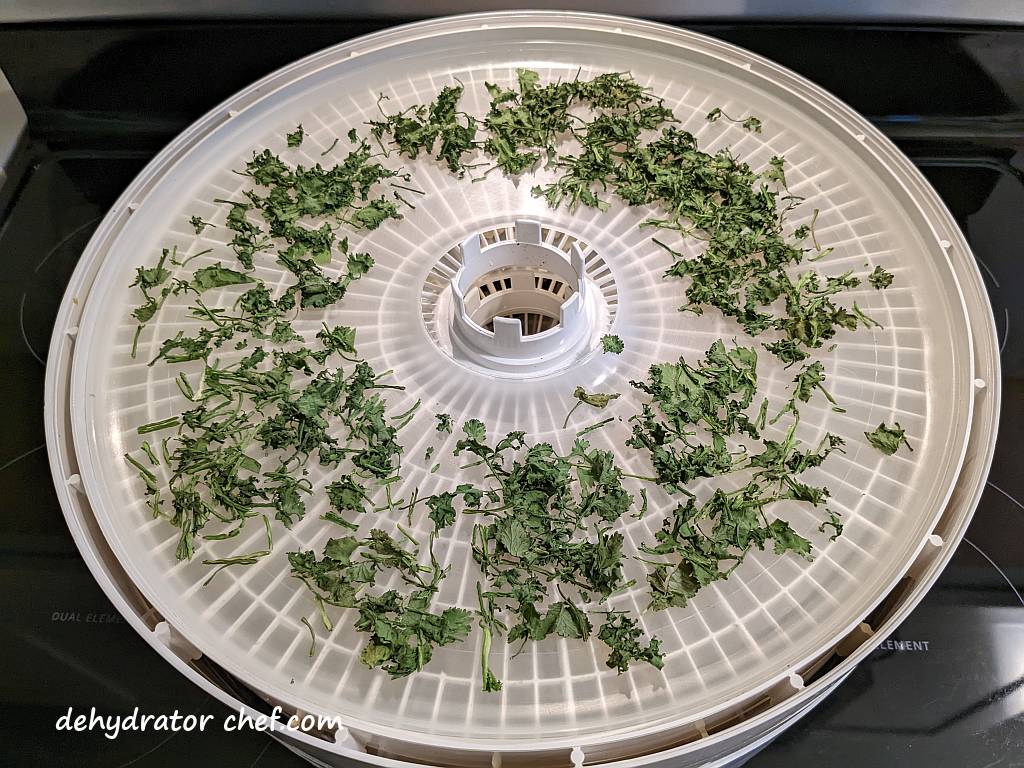
Warm cilantro still in the food dehydrator will feel somewhat bendy, and you may believe it needs more drying time. Unplug the dehydrator and let everything cool down. Then check again to be sure. When done, the cilantro pieces are brittle and should easily crush into smaller pieces.

Step 5. Equalizing and Conditioning of the Dehydrated Cilantro
We always recommend letting food items cool completely after they have finished dehydrating and before packing them into an airtight storage container for equalizing and conditioning. Warm food may cause sweating, which could provide enough moisture for mold to grow.
It does not take long for dehydrated food items to start hydrating from ambient household humidity. Do not leave dehydrated food items exposed to the elements any longer than necessary because of the increased risk of mold growth.
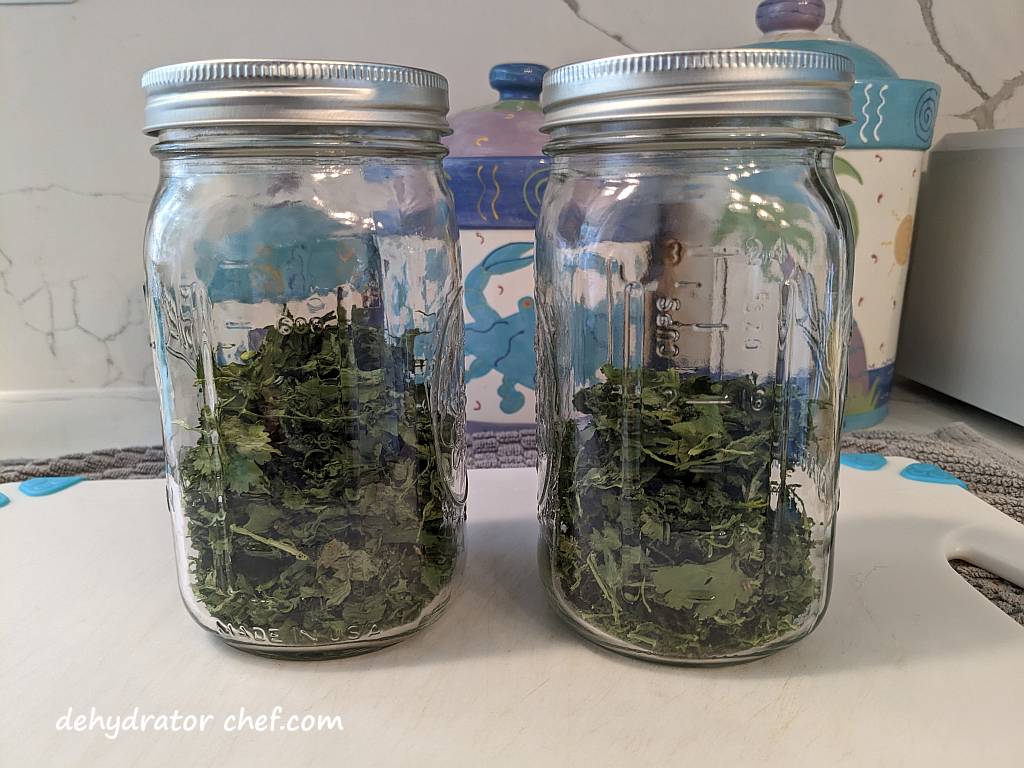
After a short cooling period, loosely pack the dehydrated cilantro into a clean, dry, insect-proof, and air-tight storage container. We use the larger quart-size canning jars for conditioning. Since the canning jars are clear, it’s easy to see what’s inside.
A wide-mouth canning jar funnel is handy for the task of getting dehydrated food from the trays into the canning jars with minimal spillage. It’s not a necessity, but having one does make the job easier and faster. If you need one, check them out on Amazon.
When the dehydrated cilantro pieces are removed from the dehydrator, the remaining moisture may not be distributed equally among the pieces because of their location and position in the dehydrator. Equalizing and conditioning is a process for freshly dehydrated foods that ensures any residual moisture remaining in any piece is spread or equalized among all the other pieces in the batch. Let the dried cilantro equalize and condition in the storage container for 7 to 10 days.
Every day, check the jar for moisture. Roll the jar contents around and note any clumping or sticking. If seen, put the contents back on the dehydrator for several more hours. Since canning jars are clear, it’s easy to see what’s inside.
If you notice any mold at all, even the smallest bit, throw it all out. What you see are the mold spores finally blooming enough to make them visible. But there are more, even tinier mold spores in the rest of your jar that make your dehydrated food inedible. Toss it out and start another batch.
Step 6. Storing Dehydrated Cilantro
Use an appropriately sized canning jar for storage. The dehydrated cilantro might keep up to 12 months. Exactly how long depends on how well you dehydrate the cilantro and your pantry storage conditions.
We’ll use a food-safe desiccant packet for moisture control because we live in a fairly humid area. For our pint-size or quart-size mason jars, we’ll use a single food-safe 5-gram desiccant packet. The desiccant packets will absorb any moisture and extend the shelf life of the cilantro.
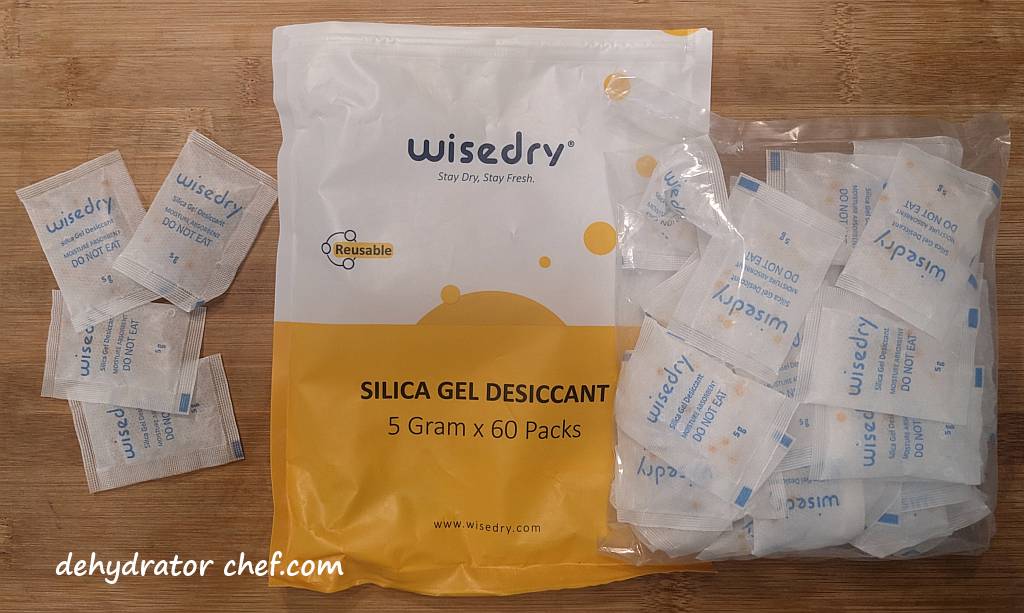
We use these inexpensive food-safe desiccant packets, which are available from Amazon. These 5-gram packets have over 5000 of mostly 4- and 5-star customer reviews, with an average of 4.7 stars out of 5. Our bag of 60 desiccant packets will last quite a while because they can be recharged and reused multiple times. Other food-safe sizes are available.
Lastly, I’ll attach or include a short note describing the jar contents and the date the product was dehydrated. The note also lets me know where to go in my dehydrator logbook if I want to make another note or two.
Spice Grinding
More often than not, our homemade dehydrated cilantro is ground up into flakes and put into spice jars.
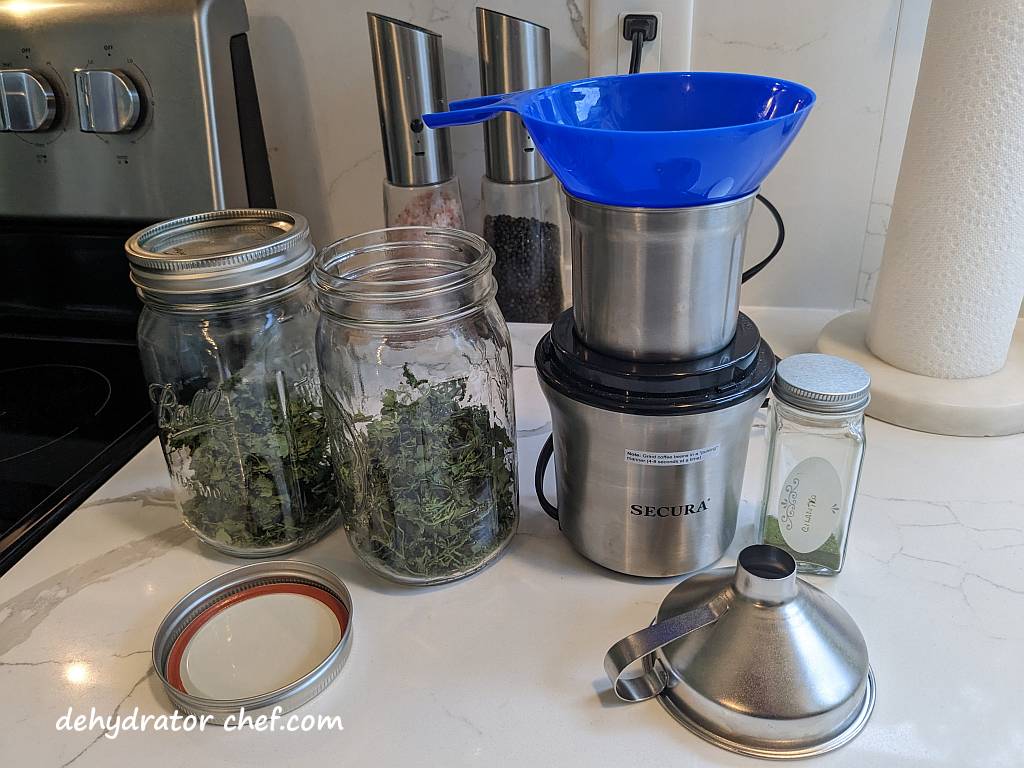
Consider using a spice grinder to make a spice powder. This is the spice grinder we use, it’s available at Amazon.com. It has close to 4,000 customer reviews, with an average of 4.4 stars out of 5. It comes with 2 grinding bowls, a 2-blade grinder, and a 4-blade chopper. It’s also easy to clean out the spice residue when you’re finished.
Use the wide-mouth canning funnel to help guide the dehydrated cilantro into the spice grinder. Then, pulse the spice grinder to the desired consistency.
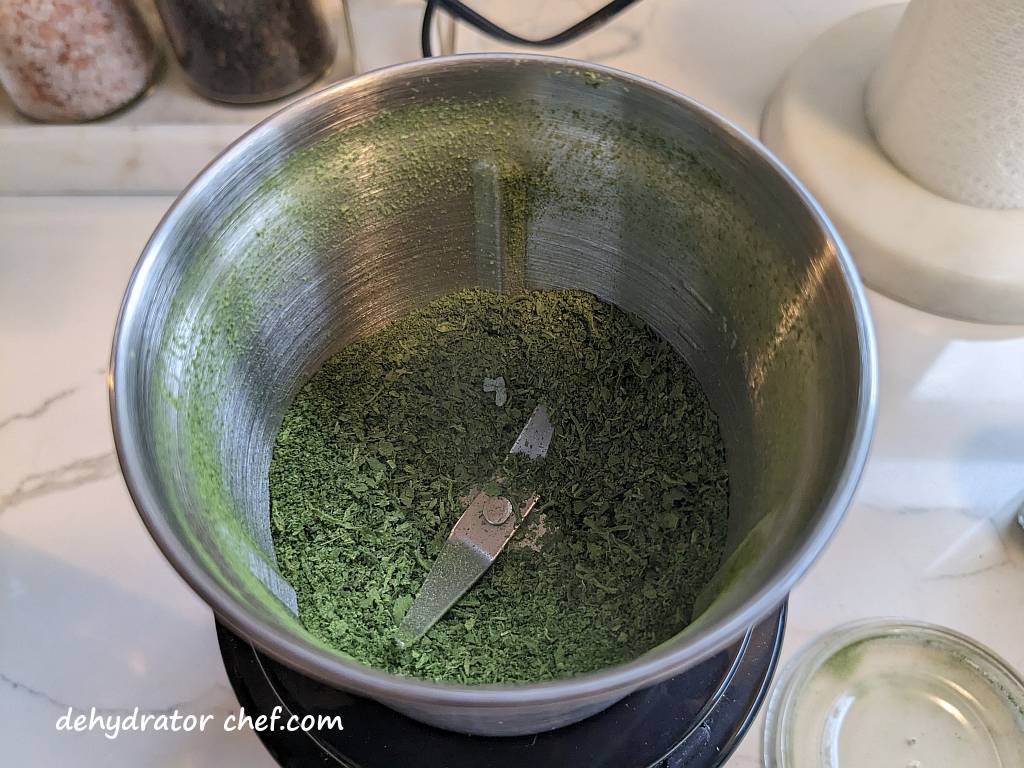
We prefer more of a flaky consistency and not a fine powder. So be sure to check the spice grinder bowl often for what you want.
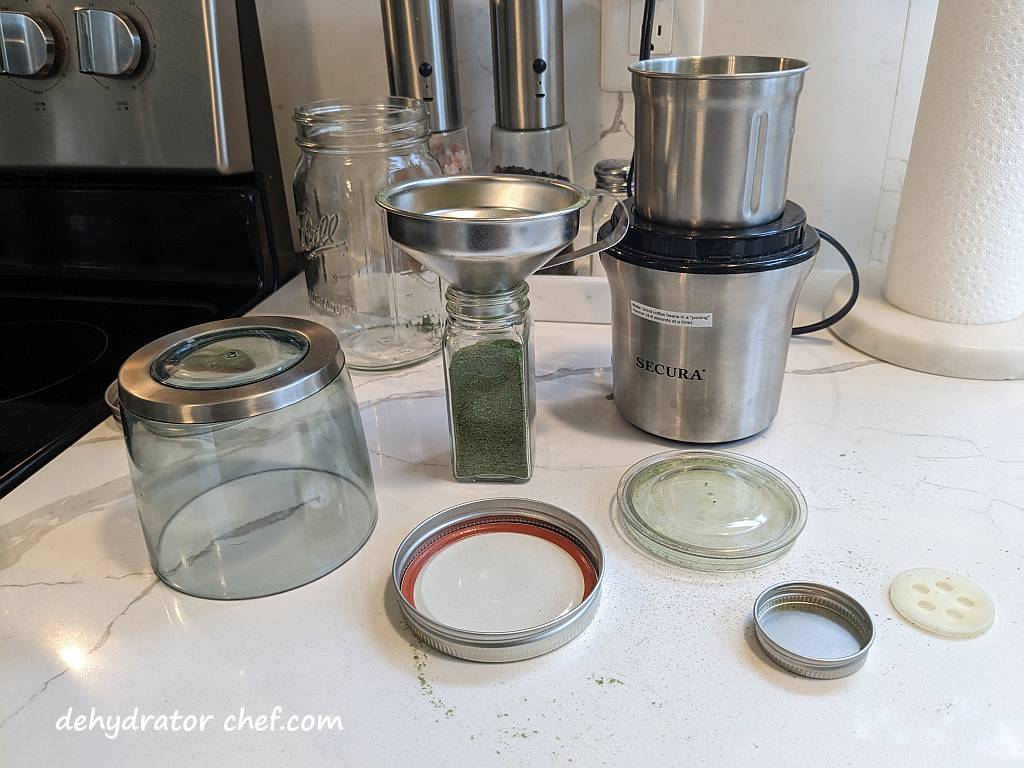
Weights, Measures, and Serving Sizes
Generally, fresh herbs are approximately a 3-to-1 ratio to dried flaky herbs. So, one tablespoon of fresh cilantro equals one teaspoon of our dehydrated cilantro flakes.
Fresh herbs to ground are approximately a 6-to-1 ratio. One tablespoon of fresh cilantro equals 1/2 teaspoon of cilantro powder.
These ratios are approximate because you’re the one doing the spice grinding. The outcome depends on whether you use a light touch or a heavy hand at the switch.
Dehydrated Cilantro Nutrition Information
Serving Size: 1 teaspoon (<1 gram) | Calories: 2kcal | Total Fat: 0g | Saturated Fat: 0g | Cholesterol: 0mg | Sodium: 2mg | Carbohydrate: 0g | Dietary Fiber: 0g | Sugar: 0g| Protein: 0g
Note: My digital kitchen scale can’t measure fractions of a gram. One teaspoon of dehydrated cilantro weighs less than one gram.
 | The Dehydrator Chef Book Available only on Amazon.com You’ll find step-by-step instructions for 26 homemade dehydrated camping meals. Many recipes are only available in this book. Grab yourself a copy today. |
Insider Tips
Besides dehydrated meal recipes found here on this website, add dehydrated cilantro to any of your favorite freeze-dried food pouches for a bit of flavor.
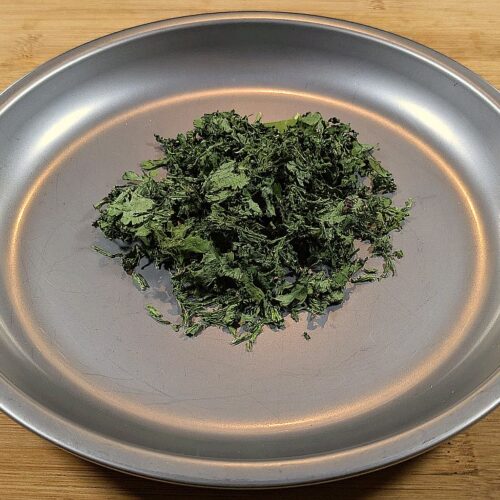
How to Dehydrate Cilantro
Equipment
- Removable fruit roll sheet insert (one for each dehydrator tray)
- Common kitchen tools (including cutting boards, chef's knife, colander, etc.)
- Canning jars with tight-fitting lids
- Desiccant packets for moisture control (optional)
Ingredients
 cilantro
cilantro
Instructions
Process the Cilantro
- Trim away the stem ends. Maybe about half an inch above the cut, just enough to remove any discoloring from the harvest cut.cilantro
- Examine the cilantro bunch and remove anything that shouldn't be there, such as wilted leaves you wouldn't want to eat.
- Cold water rinse to remove any grit or other debris.
- Finely chop the cilantro bunch into small pieces. About 1/16 to 1/8 inch (2 to 4mm) in width.
Prepare the Dehydrator
- Thinly layer the chopped cilantro onto the fruit roll sheet. If you have too much, use another dehydrator tray.
Dehydrate the Cilantro
- Set the dehydrator thermostat temperature to 135 °F (57 °C). Dry for 8 to 12 hours until done.
When is the Dehydrated Cilantro Done
- The cilantro leaves and stems are brittle and should easily crush into smaller pieces.
Equalizing and Conditioning the Dehydrated Cilantro
- After a short cooling period, loosely pack the dehydrated cilantro into a clean, dry canning jar with a tight-fitting lid, leaving some headspace.
- Every day, for 7 to 10 days, check the jar for moisture. Roll the jar contents around and note any clumping or sticking. If seen, put the cilantro back on the dehydrator for several more hours.
- If you notice any mold at all, even the slightest bit, throw it all out.
Storing Dehydrated Cilantro
- Use appropriate-sized canning jars for storage. Depending on how well you dehydrate the cilantro and your pantry storage conditions, the dried cilantro should keep for up to 12 months.
- An optional food-safe desiccant packet will aid with moisture control.
- Attach or include a label describing the jar contents and the date the product was dehydrated. The label identifies the canning jar contents, and the date helps with the rotation schedule. A first-in, first-out rotation helps us to use items that have been on the shelf the longest, so we're using the oldest food first.
Nutrition
Nutrition information is only an estimate and may differ depending on the ingredients you use.

One reply on “How to Dehydrate Cilantro – Dehydrating Cilantro, A Step-by-Step Guide”
Most recipes call for a small amount of cilantro or parsley. The rest goes to waste. The stems go to waste even though they have lots of flavor. Your dehydrated cilantro ideas are great and give me a lot of ideas. This is really helpful. Thx.